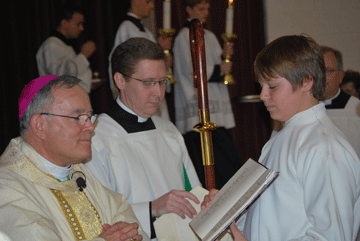In a way, when Archbishop Chaput visited St. Bede the Venerable Parish in Holland Sept. 24 to consecrate the renovated church, he was stepping into Philadelphia history.
Virtually everything of value in the church once graced West Philadelphia’s storied Most Blessed Sacrament Church, which was, in its heyday, the largest and probably the wealthiest parish in the city. Built in an era when craftsmanship was valued and money was not the principal consideration, MBS settled for nothing but the best, and now the best of the best is at St. Bede.
[hotblock]
MBS, established in 1902, built its church in 1924 and the parish became so huge its grade school topped out at 3,500 children. Nothing is forever, and it fell victim to Catholic migration and was officially closed in 2008. But for its sacred art and artifacts, it was not the end of the story.
St. Bede, on the other hand, is a suburban parish, established in 1965 with a simple A-frame church and a school completed two years later. At the time the church was blessed but not consecrated, because it was the intention of Father James Martin, the founding pastor, to build a more substantial church later. At that time the building would probably become a school hall. It never happened.
During the years of MBS’s decline, St. Bede’s was rapidly growing, and now with 11,000 registered parishioners, it is one of the largest parishes in the Archdiocese. It was just about the time the sacred artifacts of MBS became available that Msgr. John Marine, St. Bede’s pastor, and his parish councils decided it was time to upgrade. Rather than build a whole new church they would just enlarge the existing church a bit, but do a thorough renovation.
Working with architect Duncan Stroik it was decided the major elements of the MBS artifacts would work very well at St. Bede.
With the help of an almost completed $5-million capital campaign, the great crucifix, the altar of sacrifice with da Vinci’s Last Supper in bas relief, the soaring baldachin, the ambo and baptistery, kneeling angels to flank the altar, statues of the Sacred Heart and Blessed Virgin, other angels and altar rail all in fine marble were obtained, as was the huge brass tabernacle.
Most commanding is the altar enhanced by the baldacchino, with its beautiful marble pillars and mosaic-studded dome.
The Stations of the Cross executed in oil grace the side walls, and some of the best of the MBS stained glass windows, crafted in Munich almost a century ago and irreplaceable, complement the rest of the artwork.
It wasn’t just a matter of moving and installing the windows; for example the stained glass windows had to be completely disassembled, stripped of their original leading, which was deteriorating, re-leaded and hung.
The entire interior is so seamlessly installed, it is almost as if everything was designed specifically for St. Bede.
“From here on in, this is not a parish social hall,” Msgr. Marine told his people. “No, when we gather here as parish family, it is first and foremost as Jesus called the temple in Jerusalem: ‘A house of prayer where those who ask will receive. Those who seek will find and those who knock will have the door to God open up to them.’”
As for the consecration, “I have been privileged as a priest to witness the consecration of other churches, and it was especially joyful to see our parishioners witness this,” Msgr. Marine said. “The liturgy has a powerful effect that made them understand what it means to dedicate a place to God, and Archbishop Chaput explained it very well in his homily.”
As for parishioners’ reaction to the new St. Bede, it has been nothing but positive. Msgr. Marine had one parishioner who told him in the beginning she was against it, because the Mass is the Mass and it shouldn’t matter where it is celebrated. “Now as I have been coming and seeing the changes I know it does matter,” she told him.
PREVIOUS: A renovated St. Genevieve Church is blessed and dedicated
NEXT: Archbishop of Prague visits St. John Neumann Shrine, St. Peter the Apostle School




Share this story